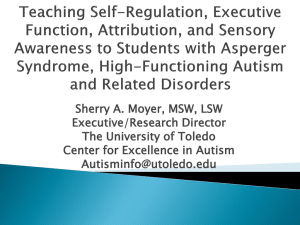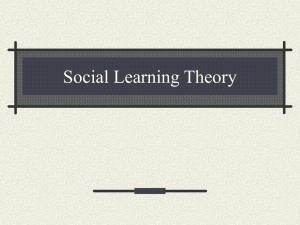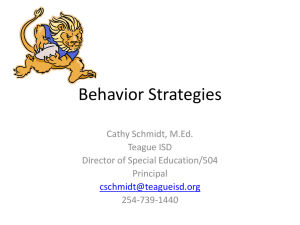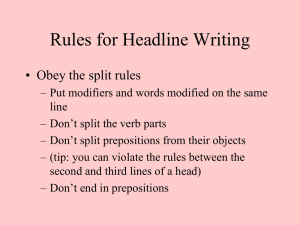controllable.
advertisement
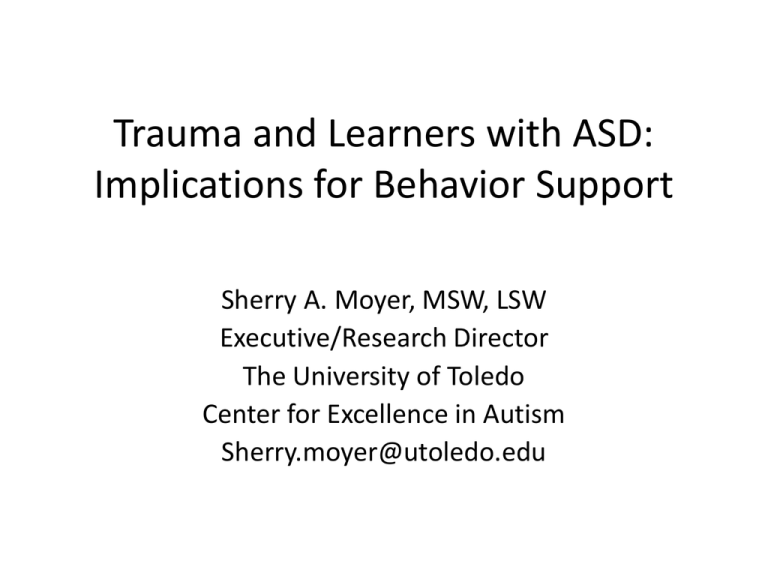
Trauma and Learners with ASD: Implications for Behavior Support Sherry A. Moyer, MSW, LSW Executive/Research Director The University of Toledo Center for Excellence in Autism Sherry.moyer@utoledo.edu Today’s lesson is… Behaviors happen when expectations meet reality! 2 Successful daily functioning means that students have the ability to… 1. Assess their circumstances. 2. Identify an opportunity for taking charge of them. 3. Respond in a way that leads to productive outcomes. 3 In order to do this students must be able to… 1. 2. 3. 4. Learn to connect cause and effect. Self-regulate their behaviors. Problem solve and respond. Recognize the connection between their behaviors and the outcomes. 5. Use their experiences to form expectations that they can continue to influence positive outcomes in the future. 4 When all of the pieces are in place students will… • Consistently participate in classroom routines with minimal disruption. • Gain confidence to engage in new activities. • Build competencies that lead to autonomous behavior that is appropriate. • Form effective expectations. • Feel reduced need to escape or avoid social interactions of any kind. • Demonstrate more consistent progress across all areas of development. 5 When even one of the pieces are missing students will… • Attempt to avoid or escape interactions or activities that are perceived as risky. • Assume or anticipate automatic failure. • Become more anxious or aggressive. • Perhaps develop anxiety or depression. • Experience unnecessary disruption to daily routine. • Over react to even the most routine circumstances as if they were a crisis. 6 The Connection Between the ABC’s of Behaviors and the Crisis Cycle 7 Let’s start at the beginning… A crisis occurs when a stressful life event overwhelms an individual’s ability to cope effectively in the face of a perceived challenge or threat. (Auerbach & Kilmann, 1997; Everly & Mitchell, 1999; Raphael, 1986; Sandoval, 1985; Schwartz, 1971; Wollman, 1993). 8 Antecedent/ critical incident Consequence behavioral, environmental, psychological Homeostatis disrupted Behavior or response to event could be a crisis Coping mechanisms fail Functional impairment 9 A look at real-life scenarios… 10 Antecedent/ critical incident – recognition of medical symptoms Consequence behavioral, environmental, psychological – reinforcement of fear, withdrawal from activities known to trigger symptoms Behavior or response to event, could be a crisis – ESCAPE! My own crisis… Disruption in homeostatis – immediate feelings of anxiety/fear of having serious/noticeable incident Coping mechanisms fail – movement, drinking water, sitting down, eating peanuts Functional impairment – feelings of being overwhelmed, perceived confirmation of failure 11 Antecedent/ critical incident – Being forced to talk with others at lunch. Consequence behavioral, environmental, psychological – loss of privileges at school, humiliation, forced to process after the fact, continuation of cycle, no meaningful change Behavior or response to event, could be a crisis – complete behavioral meltdown, bangs head, moves to other end of table, cries/screams My student with ASD… Functional impairment – feelings of being overwhelmed, perceived loss of control, confirmation of failure Disruption in homeostatis – immediate feelings of anxiety/expectation of failure Coping mechanisms fail – reflexive response in state of escalation, gets LOUD and repeats herself continuously 12 What is our REAL goal? • Change the student’s perception. • Improve the student’s coping strategies. • Provide a chance for skill building and meaningful change of behaviors. • Minimize disruption to daily routine. • Build independence and autonomy! 13 How do we change perception? 14 Attribution… Attribution is our perception or assessment of the cause and effect of events and interactions we are involved with. Our attribution patterns influence our motivation and hope for taking control of our situation and making things better! It is a key component skill of self-regulation. (Schunk & Zimmerman, 1994; 1998) 15 Attribution Retraining Very simply, attribution retraining is a cognitive approach that helps to improve our perception of cause and effect. Does not focus on whether the perception is right or wrong so much as helpless or hopeful. Allows us to interrupt the powerful influence of our amygdala or emotional brain on our ability to self-regulate behaviors and problem solve. 16 To improve the functioning you need to know who is driving the bus! 17 Emotional Brain vs. the Thinking Brain 18 Classifying the Dimensions of Attribution • Is the issue internal or external in locus? Did it happen because of something about you as a person? • Is the issue stable or unstable? Do you get the same outcome every time? • Is it controllable or uncontrollable? Can you influence the situation at all? Weiner, (1986) dylan attribution.wmv 19 The Locus of Causality self-control emotions another person’s response temperature Internal weather External effort difficulty of task popularity thoughts volume of noise in a room Conclusion: Some things are naturally part of us, some things are not. 20 When the emphasis is on locus of control… • Hopeful attribution might sound like this. – “I have done this before and it was okay.” – “Here I can help, let me do it.” – “I just need some extra time and I will be able to finish the assignment.” – “If I can use ear plugs I can go to the baseball game too.” • Helpless attribution might sound like this. – “There is nothing I can do about it.” – “Stuff just happens.” – “I don’t care what you do to me, it doesn’t matter.” – “I can’t help it, it’s not my fault.” 21 Stability ? ? temperature emotions ? Stable weather effort Unstable self-control ? another person’s response thoughts difficulty of task popularity volume of noise in a room Conclusion: Not many things will ALWAYS stay the same. 22 When the emphasis is on stability… • Hopeful attribution might sound like this. – “Most of the time I can read the book by myself.” – “I never have trouble finding a seat at lunch.” – “I usually enjoy going to the movies.” – “The 8 am train is the surest way to get there on time.” • Helpless attribution might sound like this. – “It has been this way forever.” – “She always does that!” – “I never know what comes next.” – “You keep changing the rules, how do I know what I am supposed to do?” 23 Controllability temperature weather emotions thoughts effort Controllable self-control volume of noise in a room Uncontrollable another person’s response difficulty of task Conclusion: We may have control over more things than we think! 24 When the emphasis is on controllability… • Hopeful attribution might sound like this. – “I stay away from bullies because they are trouble.” – “All I have to do is ask for a break if I feel overwhelmed.” – “There is a way to do this I know it.” – “I will follow my check list and do it myself.” • Helpless attribution might sound like this. – “It is your fault I left my lunch on the counter.” – “I just get angry, I don’t know why.” – “I can’t play with them, they won’t let me.” – “You didn’t give me enough time to finish!” 25 Putting it all together… 26 At First Look Exactly what happened? Was it internal or external? Paul found a flat tire on his bicycle when he was ready to go for a ride. Paul thinks that it was really bad luck so it is external to him. Was it stable or unstable? Paul doesn’t think about the bike but says his luck is always bad so it is stable. Assessment or Was it attribution controllable or of the uncontrollable? cause or motivation Paul figures that there is nothing you can do to control luck so it is uncontrollable. Paul decides that it is another chapter in his unlucky life. Are you motivated to take action and improve the situation? Not At All! Paul’s attribution of the situation was so helpless that he gives up on riding his bike. 27 On Second Thought Exactly what happened? Was it internal or external? Was it stable or unstable? Paul found a flat tire on his bicycle when he was ready to go for a ride. Paul’s dad remind him that tires go flat naturally over time when you don’t check them but it is still external to him. Paul doesn’t remember the last time it happened so it is unstable. Was it controllable or uncontrollable? Paul decides that by checking the tire regularly the situation can be controllable. Are you Assessment motivated to or take action attribution and improve of the cause the or situation? motivation Paul understands that it was unfortunate but easily fixed. Sure! Paul is more motivated to avoid having the same outcome in the future by checking the tires regularly.. 28 An assessment of a very bad situation in her own words…meet Mindy “I would tell them I am upset, I feel upset, frustrated I feel frustrated, I want to stop and I just can't they would tell me that I didn't try, or ignore me.” “Did I do something wrong ? I know the way I acted probably wasn't appropriate, but I just couldn't help it really, every single of my efforts to communicate was sometimes ignored, and once I started melting down and lost control I couldn't stop.” “They used a reward chart but they weren't consistent with it, and the chart was just for being good, (way, way, way too vague for me) and it wasn't used enough, I needed more immediate reinforcement.” 29 Her emphasis was on stability… “Sherry my words fail me when I am upset, people think I am manipulating or being noncompliant because I talk so much when I am okay but when I get upset I will say anything and repeat myself over and over.” “How can we keep people from thinking I am just manipulative?” “I have tried to explain that my words fail me but they don’t ever believe me, it is hopeless.” 30 Step 1 Neutralize the crisis by creating hope within the assessment of the situation: • Solution-Focused Brief Therapy (Roeden, Bannink, Maaskant, & Curfs, 2009; Lloyd and Dallos, 2006; Bannink, 2008). 31 Immediate objectives • Find the exception! – What worked and when? – Change your expectations which means changing your perceptions – Open the window for learning of replacement behaviors – Identification and expression of strengths in student – Development of tolerance for everyone Find the exceptions and begin to build hope… Things that make me feel good/successful: * gliding stars adaptive ice skating * babysitting * teaching the preschoolers * typing, since I can type very fast, and lots of words per minute. * talking to adults * horseback riding (although I haven't done this in a while) * special olympics (did gymnastics once) * helping with office work, (sorting, filling, making packets, stuffing envelopes) * drawing monsters ( I like art) * playing on my computer 33 More things that make me feel successful/good about myself * having fun, I liked camp cricket, but they don't offer it this year for my age group. * swinging on the swings, jumping on trampoline, etc (I love OT sensory equipment type stuff). * writing stories (sometimes) * listing word families randomly on a piece of paper and words that rhyme in that rhyming pattern for each word family category (if that makes any sense.) (AT: cat, sat, mat, bat, rat, brat, fat, ghat, flat, sat, hat, chat, etc.) *playing typer shark deluxe on my computer. *playing on my ipad. *searching the web, ( I LOVE google)!!!!!!!!!! 34 • The point here is if Mindy can tell us she is feels good/successful about all of those activities she can’t possibly fail at behaving appropriately all of the time. The issue is still internal to Mindy but she has decided it is unstable. • She has identified her own window of hope that might help her from becoming overwhelmed so quickly. 35 Critical skills to target for intervention IF you want behavior to change in a meaningful way… Step 2: Skill Building • Build skills in staff and students – Focus on self-regulation – The global nature of skill strengths and deficits – Appropriate boundaries – Issues of punishment versus reinforcement – Social understanding – Sensory deficits – Improved communication 37 Immediate objectives • Find the student’s strengths/interests and challenges first • Use them to develop replacement behaviors or coping strategies that are successful and help the student to avoid a crisis response • Allow for repeated practice in instructional and natural settings • Avoid reinforcing existing skills and break the crisis cycle by developing replacement skills The critical nature of Global Skills Global processes are those that contribute to cognitive development in several domains. (Kail, 2004) Flexibility/Shift Executive Function Skills Goal Oriented Behaviors Abstract Thinking Self-Regulation Causal Attribution Processing Speed Problem Solving 39 Operating Systems! Global Skills are the Human Operating System!!!!! 40 Without global skills, other skills are rote-based and not meaning-based. (Dr. Brenda Smith Myles, CEC 2009 presentation) 41 According to Mindy… “Sherry I can tell them everything I am supposed to do when I get upset, all of it, every step but I can’t DO it when I am upset so it means NOTHING.” Her assessment of her global skills is internal and hopeless which means that they fail her as a coping strategy and contribute to her becoming overwhelmed by the situation. 42 The complexities of functional self-regulation! 43 Component Skills of Self-Regulation… Identifying goals Creating strategies to achieve the goals Self-monitoring of performance for evidence of progress Configuring physical and social contexts to support achievement of goals Schunk & Zimmerman (1994; 1998) 44 Component skills of self-regulation… • Time management • Self-evaluating methodologies • Attributing causation to results • Adapting future methods Schunk & Zimmerman (1994; 1998) 45 The global nature of strengths and challenges for Mindy… Challenges Strengths • • • • Self-awareness Use of technology Verbal comprehension Use of some coping strategies • Varied interests • Understanding of need/desire to conform to expectations • Expectations of failure to cope • Previous experiences • Primary mode of communication during problem situations is NOT verbal • Trouble shifting from one idea to another • Overly reactive responses to routine situations Skill building interventions for Mindy… “Sherry I can tell them everything I am supposed to do when I get upset, all of it, every step but I can’t DO it when I am upset so it means NOTHING.” Her assessment of her global skills is internal and hopeless which means that they fail her as a coping strategy and contribute to her becoming overwhelmed by the situation. 47 Modulation… Modulation on the other hand is the ability to inhibit your behavior successfully enough to respond without over reacting. It is your VOLUME BUTTON For individuals with Asperger Syndrome, this can be particularly challenging when responding to emotional situations Myles, Dunn and Orr (2000) 48 Mindy’s Modulation Scale Situation My Response More Positive Response 1 Too much noise Feel like crawling out of skin, get anxious, disrupt activities Use break card, use fidgets 2 Peers ask me to participate in social activities Don’t answer, repeat myself a lot, get loud Say no thank you, try it, ask if they could do something I know I am good at doing 3 Staff requires me to participate in group social activities Yell, bang my head, say stupid things, act inappropriate Get sensory input first, use IPad to help type answers, keep fidgets in both hands 49 Which path will you choose? Reinforcement Replacement • Negative attention • Punishment • Mechanized decision making/problem solving • Reactive behavior management • Floating criteria for success • Contributing to the PERCEPTION OF A THREAT • Assumptions • Neutral reactions • Positive reinforcement • Proactive teaching of replacement behaviors • Realignment of expectations • Recognition of success • Practice, practice, practice • Development of global skills • Must be given time to develop tolerance Step 3: Restore functioning • Competencies – Identify mutual success • Build natural supports – autonomy! • Think long-term for progress monitoring 51 Immediate objectives • Move beyond the immediate insecurity and begin to build trust in the environment and relationships • Develop confidence to take risks and try new activities • Utilize newly mastered skills to make selfdetermined strides in quality of life… in other words experience autonomy Self-Monitoring 53 The Benefits of Self-Monitoring 1. Students spend more time on task! 2. Reduction in disruptive behaviors! 3. Makes skill assessment easier! 4. Improves student sense of self-esteem! 5. Student learns to be responsible for work production! 54 Self-Monitoring Through Task Analysis My benchmarks for this task. Yes? 1. 2. 3. 4. Read the first 3 paragraphs of the article on oil exploration. Identify at least 1 major idea from each paragraph. Record each idea in a Word file on your computer. If the first 3 benchmarks are complete, your assignment is DONE! No? X X X X 55 Visual Aids • Schedules • Choice Boards • Universal Symbols • Directional Signs • Task Organizers • I Pads/Pods - technology 56 Schedules • Create a safety net of predictability • Serves as a check list for completing required activities • Helps to reinforce appropriate behaviors • Can be written or visual with graphics or photos • Help to manage time • Are useful for EVERYONE not just people with disabilities 57 My Morning Routine Checklist… Mon Tues Wed Thur Fri Sat Sun When I get to school I have to put my coat and lunch away ____. After that I will turn in my homework at the teachers desk. I will go to my desk and read the assignments on the board. Then I will start on my assignments until the announcements start. After announcements I will gather my books and go to first period. If there is a change in the schedule, I will ask what I should do differently. 58 Building autonomy… For more information contact Valerie Paradiz at val@autismselfadvocacy.com The ISA® teaches self-awareness, competencies and autonomy in the following areas: • • • • • Sensory/ Environmental Social Self-Disclosure Strengths/ Focused Interests Entitlements and Civil Rights Monitoring outcomes • Must include self-monitoring which means global skills are functional • Lifetimes of behaviors do not change over night • Positively focused autonomous behavior demonstrated in the appropriate context is the antidote to crisis responses, trauma and the cycle of destruction it causes Sample outcomes you could choose to monitor immediately… • • • • Reduction in injurious behaviors Reduction in duration of disruptive behaviors Reduction in phobic/avoidant behaviors Anything at all associated with damage control of crisis responses 62 Sample outcomes you could choose to monitor in the short-term… • Use of modulation charts or other self-regulation strategies • Increased self-awareness of triggers, needs, preferences • Increased engagement in routine daily activities • Willingness to ask for help • Increase in number of successful social interactions • Decrease in visible signs of anxiety 63 Sample outcomes you could choose to monitor in the long-term… • Active use of self-monitoring strategies • Ability to independently initiate necessary modifications/accommodations • Increase in number of social activities, relationships etc. • Improved adaptive or self-help skills • Improved academic performance • Improved performance in other areas of functioning • Decrease in symptoms of hopelessness or depression 64 Some of Mindy’s more notable outcomes… • Reduction in injurious behaviors • Reduction in duration of disruptive behaviors • Reduced anxiety surrounding coping mechanisms • Use of ISA® self-advocacy scripts to increase number of successful social interactions • Consistent demonstration of more hopeful attribution and expectations of success 65 Mindy’s thoughts on her progress… “I have always known when things go wrong but now I can control my thoughts and responses more often. Autism is the way my brain is wired but it will not ruin my life, I can go places and not be scared about my behavior.” 66 Thank you for having me! Sherry A. Moyer, MSW, LSW Executive/Research Director The University of Toledo Center for Excellence in Autism Sherry.moyer@utoledo.edu
